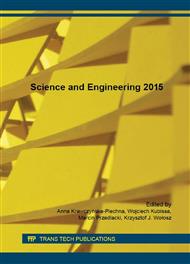p.145
p.151
p.158
p.166
p.174
p.185
p.192
p.202
p.210
Optimized Thermal Performance Design of Filled Ceramic Masonry Blocks
Abstract:
Clay brick as building material has been used for thousands of years. Nowadays, the energy performance of new products has to meet rigorous requirements, therefore in design of fired clay blocks, building physical calculations and optimization are essential. The aim of this research is to design optimized fired clay building blocks using numerical finite element thermal simulations supported by laboratory tests. The paper analyses 38 cm or 44 cm thick hollow building blocks occurring nowadays in the industry, taking into account of single blocks as well as tongue and groove connections. The study compares blocks having different internal structures: rhomboid, triangular and small or big rectangular gaps. It also deals with the effect of different fillings: air, expanded perlite, mineral wool, polyurethane (PUR) foam and aerogel. During the research, 20 different masonry elements were analysed using the above-listed varying parameters and the equivalent thermal conductivities were compared.
Info:
Periodical:
Pages:
174-181
Citation:
Online since:
November 2015
Authors:
Price:
Сopyright:
© 2015 Trans Tech Publications Ltd. All Rights Reserved
Share:
Citation:


